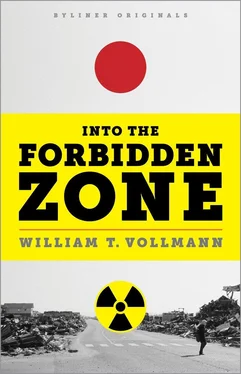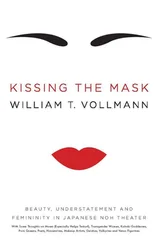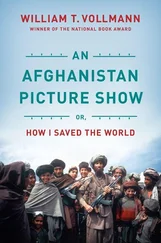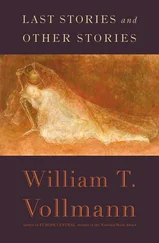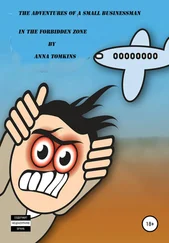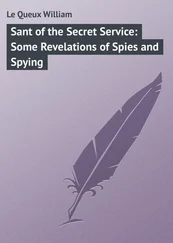In the filth, muddy dishes were neatly stacked. Freshwater was still too rare for washing just yet.
At my request, Mr. Kawanami took me upstairs to admire the sand and silt. He said: “When the wave came, each tatami mat struggled like this!” and his arms writhed.
Thanking him and departing with my best bow, I was next introduced to Mrs. Ito Yukiko, age sixty-six, who received me narrow-eyed, with her shoulders drawn in and her fists on her lap as she sat on the edge of her chipped, cracked concrete porch, wearing orange wind pants, a dingy sweater, and a white-striped wool cap pulled down over her eyebrows. The toes of her slippers touched the mucky, rubbly ground, which happened to be decorated with broken dishes. Here as everywhere else in that neighborhood the smell of diesel was nauseating. Her two young granddaughters, wearing galoshes, played at sweeping the doorway, then settled down to read what might have been comic books. They were very shy; I left them alone. I did not ask, since no one mentioned them, where their parents might be.
“I was born in the beach area,” Mrs. Ito said. “I have experienced the Chilean tsunami, and also another one in this prefecture. So I knew well that when an earthquake comes, you have to take care in case of a tsunami. But this one,” she said, grimacing (and stopping to pick up a spoon that one of the little girls had dropped), “this one was different.”
Well aware that quake-deformed doors might trap people behind them, she had carefully opened the house door in advance, then rode out the temblor just within, for fear of getting brained by her roof tiles. Unlocking the safe, she removed “the memory of the ancestors,” evidently their Buddhist memorial tablets, and then, believing she still had time, searched for a cotton furoshiki cloth in which to wrap them. One of the granddaughters then suggested that she might wish to take the cell phone. And so they fled in the car. Sending the two girls ahead, she returned to the vehicle to retrieve their dog and her wallet. Here her hands began twisting tighter and tighter together in her lap, and when she said, “I took a narrow way, and then I saw the tsunami in the middle of the road,” I found the horror in her round reddish face nearly unendurable.
“The first wave took all the belongings away from me, so then I ran to where the wave was lower. I know that a human cannot escape the tsunami once she is caught in it, so I removed my shoes and climbed a wall, and first it was unstable, but I found a stable place, clinging with my toes. The water was up to my waist, and then it was up to my chest; I was holding onto the roof so that I couldn’t be carried away; I was screaming help, help, help! to the spirit of my late husband. . Then it came.”
The grandchildren went on reading books in their galoshes in the fishy, diesely wind (and since it might for all I knew be blowing from the reactor, I inspected my dosimeter, which at six in the morning had been reading 1.9 accrued millirems and now after three hours in Ishinomaki turned over to 2.0, which signified that the radioactivity here was at least twice that of Tokyo’s — not bad; never mind those hypothetical beta particles riding on the wind); and a crow cawed; there was a heap of tires; from a glassless window, sodden futons hung out to dry.
“I was on the rooftop, so I was rescued at the end, before it got dark. I didn’t see my granddaughters for two days, but their teacher told me they were all right. .”
Behind a leaning grate, her old neighbor was picking up clinking things from the mud of his former yard.
“How relevant is the nuclear accident to you?” I asked her.
“The power plant may be necessary, but they ought to publish the facts. It seems to be stopped all right, but is it really? They’ve said that in some fishery products the concentration is low, but accumulation will be bad. .”
Gazing down at the sand by her feet, I saw a small fish-mummy, convulsed.
In a narrow zone of sand between two ruined houses, an old man was planting seeds. Streams of plastic twitched in the tsunami-pollarded trees. A twisted cypress, still green, rested against the patio wall of a house that had been smashed open on its eave-end. I bowed goodbye to Mrs. Ito, who slowly crept into her house.
CONCERNING A KOTO NOW UNDER REPAIR
HOW MANY SUCH STORIES would you care to hear? I collected a number; they are much the same in the one quality that causes journalists to seek them out, just as are the grimacing, often swollen, frequently forehead-bruised corpses whose images face us on the fluttering blue tarp-wall of that temporary morgue at Ishinomaki; their expression much depends on the angle of the head. The survivors who view them keep calm, in the best Japanese manner, gesturing each other forward with a polite “hai, domo!”, offering one another the best views of those horrid faces, whose eyes are usually closed.
One woman was explaining to another: “I came here to look for my mother-in-law, but since the faces are swollen it’s difficult, and the number I specified was wrong; that’s why I couldn’t identify her right away. .”
On the other side of the long rectangle of sunlight, a priest was ringing a bell, and a photograph gazed down upon a bed of donated flowers. Relatives bowed over the ritual bowl; candles flickered. The priest bowed. My throat ached with dust.
Thinking to learn more, I asked a policeman for information, so he referred me to his chief, who could do nothing without the big boss, who when I asked him how many people had died in Ishinomaki rewarded me with a perfect answer: “Our policy is not to answer regarding the individual numbers.” Bowing and thanking him, I said that in that case I had no further questions; reddening, he bowed deeply and apologized for keeping me waiting.
So let us at least momentarily leave the narratives of loss at rest with their eyes closed (the bulldozers clearing more long narrow corpse-trenches in the dirt, twenty bodies per line, three temporary cemeteries in Ishinomaki, and a long green line of Self-Defense Forces dividing into two detachments to break open buildings in search of bodies), while we consider what meaning, if any, we can find in them. In this context let me now reintroduce you to Takehiro’s mother, Mrs. Utsumi Yoshie.
“What lesson if any do you see in this event?” I asked her.
“Since March 11, something is finished. I feel that something different has begun. We have never had the experience of losing everything to this extreme. The good lesson,” she laughed, “is to keep valuable things on the second floor!”
“Will your lives be worse?”
“Of course I believe they’re going to be better,” she replied, sitting with me in the dirty wreckage inside her house, with smashed things everywhere.
“Why?”
“Well, I don’t know why. The passage 22of daily life will create another sense of value. Unless you think that way, you cannot advance.”
I told her how brave I considered her and all of them to be, at which she remarked that for some time she had been taking lessons in playing the koto, a traditional stringed instrument the notes of which I have sometimes been graced to hear in Kyoto’s and Kanazawa’s secluded teahouses: slow, quiet, and (to me) melancholy notes reassembling some blurred ghost face out of the melodies of olden times. I hope never to forget how it was for me in that small chamber in Gion when the lovely old geisha Kofumi-san danced the “Black Hair Song,” to which Kawabata and Tanizaki allude in their greatest novels. 23It pleased me that Mrs. Utsumi also knew and indeed had mastered this tune, whose simple mention made her faintly smile. For a fluttering instant the two of us lived again in the Japan of March 10, 2011—the day before Ishinomaki became newsworthy.
Читать дальше
